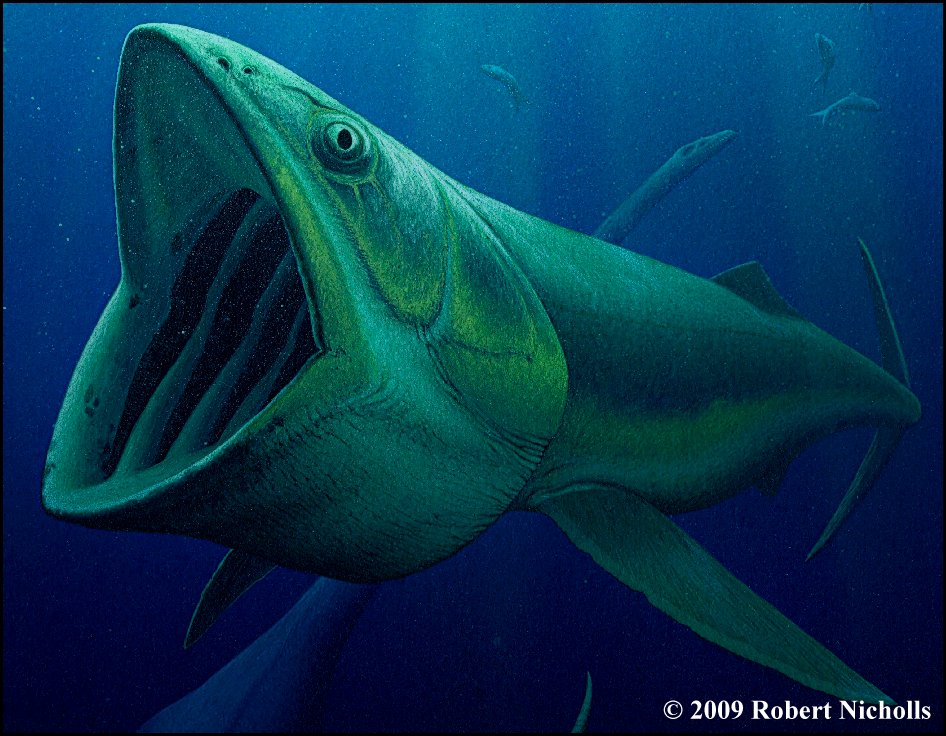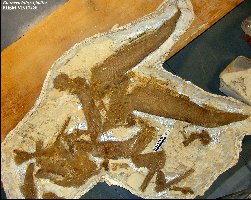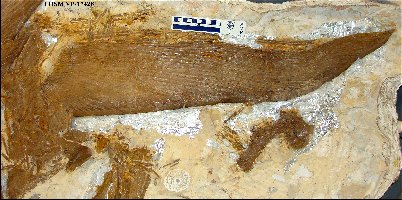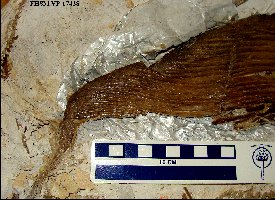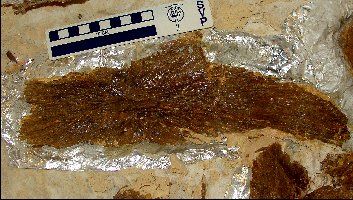| Published in Science February 2010: Friedman, M.,
Shimada, K., Martin, L., Everhart, M.J., Liston, J., Maltese, A. and Triebold, M. 2010.
100-million-year dynasty of giant planktivorous bony fishes in the Mesozoic seas. Science
327:990-993.
Supplement to article in Science
on line here (2 MB) |
"Protosphyraena" gladius (Cope 1873) is a fourth
(and a very large) kind of pachycormid fish that lived in
the Western Interior Sea during the Late Cretaceous. It was originally named from a large
pectoral fin collected by B.F. Mudge from the Smoky Hill Chalk
along the Solomon River in Kansas. Initially Cope (1873) had named it Portheus
gladius, but by 1875 he had changed the name to Pelecopterus gladius, based
in both cases only on the extremely large pectoral fin (below). Eventually all three of
Cope's "swordfish" genera were referred back to Protosphyraena
(Leidy 1857).
 |
LEFT: The fin of "Portheus" gladius as
figured by Cope (1875, Plate LII, fig. 3) from a specimen collected by B.F. Mudge (AMNH
1849). Cope wrote (1873. p. 338): "Established
on a spine which I have supposed to be pectoral, and which resembles one I have described
(loc. cit. p. 332) as from P. molossus or P. thaumas. It is, however,
relatively much thicker than that one, and absolutely much larger, and might pertain to
the P. lestris, but there is no evidence to that effect." |
"When complete, the spine measured, according to Professor Mudge,
forty-one inches in length; the portion now before me measures thirty-one inches. The
margin is exceedingly acute, and is coated with an enamel-like layer, which conceals the
extremities of the rods of which the spine is composed. Near the middle of its length,
these rods number thirty; but whether the entire width of the spine is preserved is
uncertain. The transverse section is a crescent from the base to beyond the middle; the
surface being thus somewhat trough-like. The spine has been somewhat distorted by
pressure; but I cannot discover that the form in question is entirely due to that cause.
The edge is excavated and notched at irregular points, indicating the frequent use to
which this formidable weapon was put during the life of its possessor. Discovered
by Prof. Mudge near the upper waters of the Solomon River, Kansas."
Cope (1875, p. 244) remarked that, "This is a formidable weapon, and could
be readily used to split wood in the fossilized condition." |
That was all well and good, except for the fact that more than a hundred years
later, "Protosphyraena" gladius would turn out to be something
other than a swordfish. According to Stewart (1988) the fins of this species have
some distinct characteristics that may set it apart from other species of Protosphyraena.
At the time, the skull of P. gladius was unknown, so it was not certain that it
even had the sword-like rostrum of P. perniciosa, P.
nitida and P. tenuis.
 |
LEFT: This nearly complete pectoral fin (FHSM VP-212) is in the
Sternberg Museum collection (88 cm long, 20 cm wide at the base) that was collected by
G.F. Sternberg in 1949 from the chalk in eastern Gove County, Kansas. Proximal end of the
fin edge is HERE -
Distal tip of fin edge is HERE. |
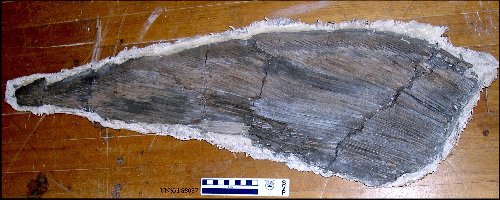 |
LEFT: A P. gladius pectoral fin from a fairly complete
specimen (UNSM 88507) discovered by amateurs in 1992, and collected by the University of
Nebraska State Museum from the base of the Pierre Shale along the south shore of the
Harlan County Reservoir in south central Nebraska. |
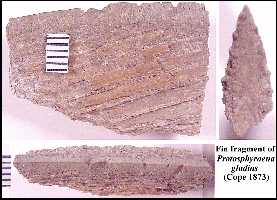 |
LEFT: Although a fair number (about 20) of specimens of the fins
of this species have been collected from as far back as the 1870s (Stewart (1988), up
until now, I had only collected a small piece of one... the fin fragment shown above left,
discovered a little ways north of Castle Rock in Gove County. In cross-section and
front view, this fragment illustrates the sharp leading edge of these fins. |
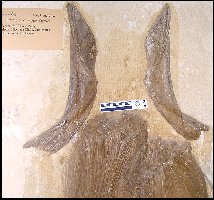 |
LEFT: A pair of fins and associated shoulder elements (cleithra)
in the University of Kansas collection (old KUVP 508 / new KUVP 465), collected by George
F. Sternberg from Logan County, about 1912. Note that Protosphyraena gigas
(Stewart, 1899) is a junior synonym of P. gladius (Cope, 1873). The
"type specimen" (KUVP 338) of P. gigas was collected in 1898 by Albin
Stewart, from the Pierre Shale east of McAllaster, Kansas. |
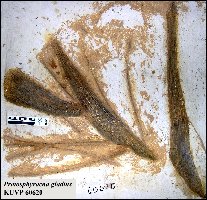 |
LEFT: One of the 'exploded' pectoral fins of KUVP 60620 collected
in 1969 by Marion Bonner and donated to the University of Kansas Another,
more complete specimen (KUVP 60692) was discovered by Chuck Bonner in 1971, and
subsequently collected by Marion and Orville Bonner. When prepared out nearly 40
years later by Triebold Paleontology, it was found to contain portions of
the skull of a fish much more like the filter feeding Leedsichthys than the
predaceous Late Cretaceous swordfish, Protosphyraena perniciosa. ... No giant
sword-like beak, and no sharp, knife-like teeth, just a large, basket shaped mouth, large
gill arches and huge pectoral fins.... The specimen was briefly discussed by Friedman, et
al. (2007) at a meeting at the University of Glasgow (See abstract below). |
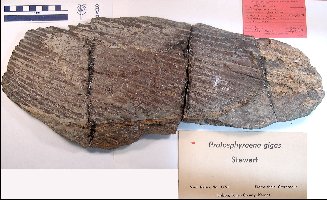 |
LEFT: The type specimen of "Protosphyraena
gigas" Stewart 1899 (KUVP 338) from the Sharon Springs Member of
the Pierre Shale, Logan County, KS. In this case, however, it is actually
one of the few Kansas specimens of Bonnerichthys gladius from the
Pierre Shale.
Stewart, A. 1899. Notice of three new Cretaceous
fishes, with remarks on the Saurodontidae Cope. Kansas University
Quarterly 8(3):107-112. |
55th
SYMPOSIUM OF VERTEBRATE PALAEONTOLOGY AND COMPARATIVE ANATOMY and 16th SYMPOSIUM OF
PALAEONTOLOGICAL PREPARATION AND CONSERVATION - The University of Glasgow. 28th
August - 1st September 2007 (ABSTRACTS, Page
14)
New insights on the Upper
Cretaceous pachycormid ‘Protosphyraena’ gladius (Actinopterygii:
Teleostei) from North America
Matt Friedman1, Kenshu Shimada2
and Anthony Maltese3
1 University of Chicago, Committee on
Evolutionary Biology, 1025 E 57th St., Chicago, IL 60637, USA
2 DePaul University, Environmental
Science Program and Department of Biological Sciences, 325 North Clifton Avenue, Chicago,
Illinois 60614, USA
3 Rocky Mountain Dinosaur Resource
Center, 719-686-1820 Woodland Park, CO, USA
'Protosphyraena’
gladius is an
enigmatic pachycormid from the Late Cretaceous of North America, where it
is known from the Coniacian-Campanian Niobrara chalks and the Campanian Pierre Shale and
Selma Formations. Described remains of this species consist exclusively of pectoral fins,
which can exceed one metre in length. Features of these fins link ‘P.’ gladius to pachycormids (Lambers, 1992), but
provide no evidence linking it to other species of 'Protosphyraena'. Newly prepared material of ‘P.’ gladius reveals details of the skull roof,
neurocranium, jaws, hyoid and branchial arches, operculogular series, and shoulder girdle.
These remains indicate that ‘P.’ gladius cannot be placed within ’Protosphyraena’. Unlike that genus, ‘P.’ gladius is edentulous and lacks anterior
extension of the rostrodermethmoid into a prominent rostrum. While ‘P.’ gladius is not closely related to 'Protosphyraena', it is very similar to two Jurassic
pachycormids: Asthenocormus
and Leedsichthys (Lambers, 1992). These two taxa appear
to have been ram filter-feeders, and one of them–Leedsichthys– reached enormous sizes (Liston
& Noč, 2004). ‘P.’ gladius also displays features consistent with
filter feeding, and extends the range of this large-bodied pachycormid clade from the Late
Jurassic to the Late Cretaceous. This range extension also fills a conspicuous ecological
gap: no large-bodied filter feeders were known previously from the Cretaceous. The
apparent extinction of this group of pachycormids at or near the end of the Cretaceous is
also intriguing, because it occurs shortly before the earliest records of large-bodied,
ram filter-feeding chondrichthyans (rhincodontids, cetorhinids, mobulids) in the earliest
Paleogene (Shimada, 2007). |
Based on this accumulation of evidence, Protosphyraena gladius was
renamed in 2010, becoming Bonnerichthys gladius in honor of the family who
collected the first partial skull of this enigmatic fish.
Friedman, M., Shimada, K., Martin, L., Everhart, M.J., Liston, J., Maltese, A.
and Triebold, M. 2010. 100-million-year dynasty of giant planktivorous bony fishes in the
Mesozoic seas. Science 327:990-993.
The newest and most complete specimen of Bonnerichthys gladius -
FHSM VP-17428
| July 5, 2008 |
|
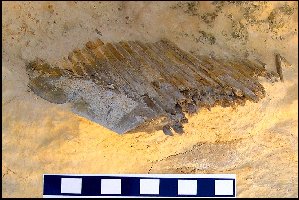 |
LEFT: On July 5, 2008, Kenshu Shimada discovered the
broken end of a Bonnerichthys gladius fin eroding from the middle-chalk (just above
MU 9) of Gove County, Kansas. There was probably 8-10 inches of it missing when we first
saw it. It had probably been slowing eroding out for several years. The temperature, under
clear blue Kansas skies, was only about 95 degrees F (35o C) at the time... it
would get hotter. We (Kenshu, Tom Nolan and myself) were able to
remove the fin in a block of chalk, but had to leave the rest of the remains... largely
unknown .... until June, 2009. |
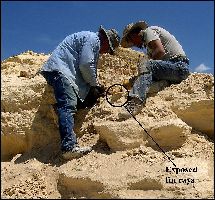 |
LEFT: After the removal of about 18 inches of
overlying chalk, Kenshu and I worked to cut a trench around the block that includes the
fin... Note that most Bonnerichthys gladius specimens are limited to one or two
large pectoral fins. We weren't expecting to find nearly the whole fish! |
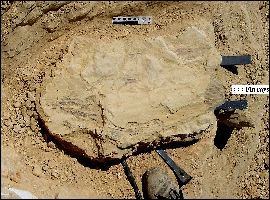 |
LEFT: Here's the block just before we broke it loose
from the chalk by inserting chisels underneath the block... It came free easy enough, but
in the process we discovered that the chalk was fractured at odd angles to the bedding
plane, probably the result of the general slumping of the exposure downhill to the west.
The fin itself was not fractured but the loss of some underlying matrix gave us a few
anxious moments. In retrospect, we could have wrapped the block in a
plaster jacket, but my major concern at the time was getting us out of the sun. The
temperature when we left the site was about 106o F (42o C)... and I
was beginning to get the chills (warning sign too much heat).
We could see additional bone at the edge of the excavation and I ended up with the
responsibility for coming back to the site to complete the dig... but the nature of
paleontology being what it is, several other "must do" specimens showed up in
the meantime and it took almost a year for me to get back on the site. |
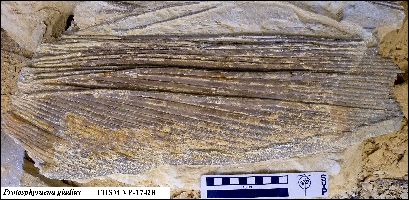 |
LEFT: Here's the fin as prepared (Photo by K.
Shimada) - Note the heavy and relatively sharp leading edge (lower side of photo): |
| June 14, 2009 |
|
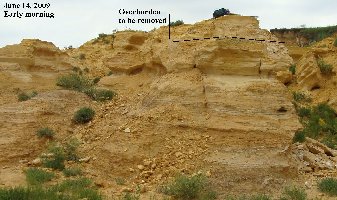 |
LEFT: We returned to the sited on June 14, 2009...
There had been a brief rain overnight and the last two miles of dirt road was a bit
'greasy'....
It was still cloudy and I hoped that the temperature would stay reasonably cool... which
it did....
The chalk was still fairly damp when we pulled up, looking several shades darker than
after being baked in the sun.... The black line shows the layer of chalk that was lying on
top of the remains.... and the limit of this phase of the dig.... |
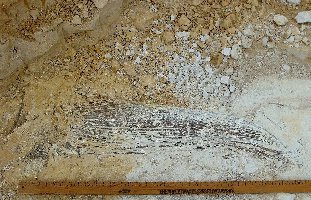 |
LEFT: The chalk was damp and easy to remove. The
first thing that I uncovered was a large (about 30 inches; 70+ cm) and complete pectoral
fin... which I assumed was the mate to the one that we had removed in 2008. To the left of
it were several large bones which turned out to be part of the pectoral girdle.
|
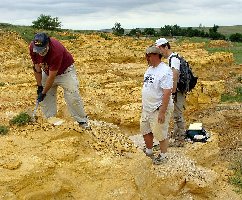 |
LEFT: At this point, it was apparent that we were
going to have to remove more chalk, so Tom grabbed a pick and started taking off 18+
inches of overburden. We enlarged the "floor" of the dig by a space about 6 feet
wide and 5 feet further back into the hill. The cardboard by Fred and George's feet covers
the newly exposed fin and protected it from damage as we cleared off a couple of cubic
yards of chalk. |
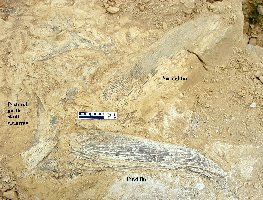 |
LEFT: I got back to work and took the remain 4-6
inches of chalk off the bones.... and opps, that wasn't supposed to be there ?!? .... I
was very surprised when a third "pectoral fin" showed up... more than likely the
mate to the first one I had uncovered earlier in the day. So what was the fin discovered
in 2008? Part of the caudal perhaps? There were more bones from the pectoral
girdle and odd shaped plates that appeared to be part of the skull. |
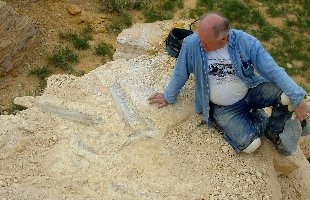 |
LEFT: By about 2 PM it was certain that we had a
bigger project on our hands than we were equipped (time and materials) to handle... and
there were still more bones going back into the hill. I reluctantly covered
everything up and made plans to come back another time. |
| June 18, 2009 |
|
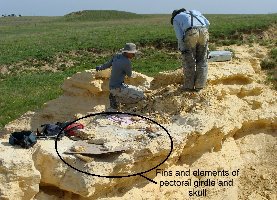 |
LEFT: Back to the site on June 18, 2009... I returned
to the site early on the morning of June 18 with Mike, Anthony and Jacob of Triebold
Paleontology. They were working on some other fossils in the chalk further west and
generously came over to help me with the big fish....
The first we did was to remove a lot of additional overburden to the east of the
remains... Mike had brought along a portable generator and electric jackhammer that made
the initial work go very quickly. |
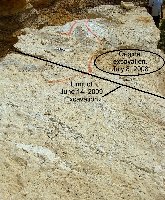 |
LEFT: Once the 18-24 inches of chalk was removed, we
brought the floor down to the level of the bones again.... and found more bones.. A closer
inspection of the edges of the ridge showed a few places where bone was still eroding
out.. but mostly it was limited to the abundant "ribs" or "fin rays"
that were scattered across the site. From all indications so far, it appears that
the gullies on either side of the ridge did not remove much in the way of major bones. We
were fortunate in having cloud cover and a decent breeze most of the day, but it was still
hot, dirty work.
This photo from the east side shows the site once it was cleared in middle of the
afternoon. The fluorescent paint marks the edges of the slab that we planned to remove in
a large jacket... Mike T. used the paint as a marker when he was cutting the chalk with
the chain saw. |
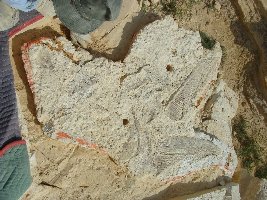 |
LEFT: Cutting the chalk away with a chain saw is
dusty, dirty work, but it provided us with nice straight edges to build the jacket around,
and minimized the potential for damage to the fossil by cutting around the block with
hammers and chisels. |
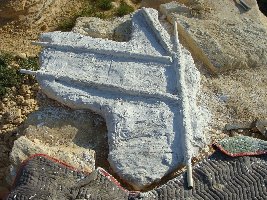 |
LEFT: Anthony and Jacob built a really strong jacket
around the irregular mass that we choose to remove... The clouds had disappeared and it
was so hot by then that Mike and I had to mix the plaster in small batches so it wouldn't
set up while Anthony and Jacob were coating and applying the burlap strips... The metal
pipes were attached last to stiffen the jacket and provide hand holds when we lifted and
moved it. We let the jacket cure for over an hour... hoping to make it
just as strong as possible. Having helped Kenshu remove the first fin in 2008, I was
really concerned with the condition of the chalk under the jacket... In most cases, the
chalk is a solid layer under the bones in a jacket, but I knew that it was fractured under
this specimen. We worked for another hour to drive chisels under the jacket to break the
chalk free, but even then we weren't really sure what would happen when we turned it... |
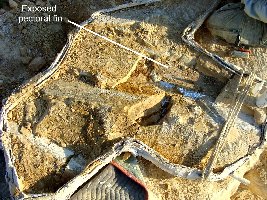 |
LEFT: When we finally lifted the jacket, Mike and I
were standing in the gully pushing it up while Anthony and Jacob pulled it up from above.
We immediately noticed one block of chalk falling out of the jacket but it was too late to
stop... While Anthony and Jacob rotated the jacket to vertical, Mike and I raced around to
the other side of the ridge to help them lower it down... Once we had it down, we found
that a BIG block of chalk under one of the fins had dropped off... but the fin was still
safely in place... it might look pretty ugly, but we recovered 100% of the bone that we
wanted in the jacket. The rope around the end of the jacket was my
last-ditch attempt to assure myself that it wouldn't fall out in a pile...
|
| JUNE 26, 2009 |
|
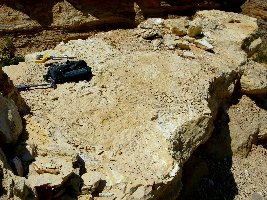 |
LEFT: I returned to the dig site on June 26 to do
some clean up and to put a better cover on the remaining portions of the specimen. I also
wanted to remove some of the bones on the southeast corner of the fossil floor.
Here's an oblique view of the dig area, from the northeast looking generally to the
southwest. The rubble used to hold down the temporary cover (cardboard) is piled in
the spot where we took out the large plaster jacket on June 18. There had been enough rain
in the meantime to erase our tire marks, etc. from the previous visit but no damage to the
fossil. It was also evident that the fragments of the relatively "tough" chalk
that we had been digging through had fallen apart when exposed to rain... one of the less
desirable features that rightfully keeps the chalk from being used as a building stone.
Note that a group of ~30 inch long fin rays is visible near the center of the photo. |
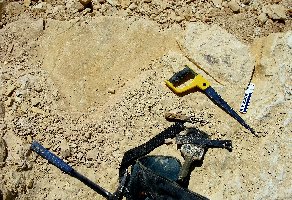 |
LEFT: This is a closer view of the area on the
southeast corner of the dig area where I began removing the chalk containing some of the
larger bones in slabs. This area is sitting on an overhang that is likely to fall off in
the not too distant future. There was also a good 'parting layer' about 2 inches under the
bedding plane of the bones and I used a hand saw as well as the existing fractures of the
chalk to divide the slabs in to manageable pieces. Fortunately, only one small area of
"fin rays" needed to be sacrificed on the last slab that I removed. In the
process, the slabs created a jigsaw puzzle that can be re-assembled during preparation. Incidentally,
the little saw was a BIG help... not as quick as a chain saw but handy. |
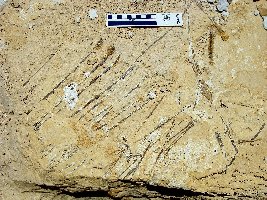 |
LEFT: On the extreme west end of the dig area, there
are bones that were naturally exposed by weathering.... the bones are long and slender
with an expanded area at one end. In this picture they are more or less regularly spaced
and look more like ribs than anything else to me... but will probably end up being part of
the gill rakers... |
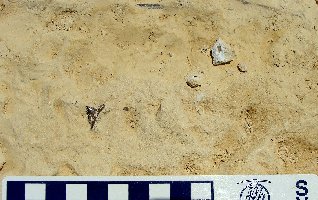 |
LEFT: On June 18, Anthony found the only shark tooth
as yet associated with the remains (Squalicorax falcatus). Although no evidence of
scavenging (bite marks) has been observed, finding a shark tooth intermingled with bones
(top of photo) is a pretty good indication. It would be unreasonable to assume that
several tons of dead fish would not attract scavengers of all kinds. |
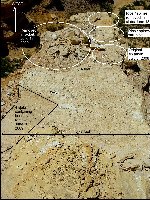 |
LEFT: Here's another explanatory diagram of the
layout of the big fish site .... taken while standing on top of the ridge at the east end
and looking generally to the west. |
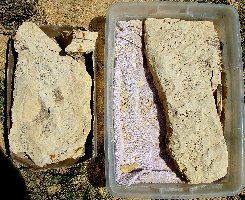 |
LEFT: The first two slabs that I removed, prior to
packing them for travel. Although the bones are not readily visible due to the covering of
chalk, most the the surface contains one or more of the larger sized bones.
|
| July 29, 2009 |
|
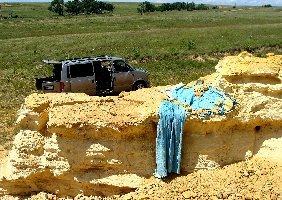 |
LEFT: UPDATE: I returned to the site on the
afternoon of July 29... We have been having more than normal rainfall this summer, usually
associated with thunderstorms and wind - (and cooler weather!)... western Kansas is not
normally green by the end of July.
I was concerned about the tarp that I had put over the specimen... and as it turned out, I
had good reason to be... the chunks of chalk that I used to hold down the tarp had
literally dissolved in the rain and allowed the wind to push the tarp up around the head
wall of the dig....However, I was pleased to find that nothing had been damaged... Note
that exposure to the elements, especially fish bones, is usually beneficial to some
extent, hardening them... |
 |
LEFT: A Squalicorax falcatus tooth found
among the ribs... the chalk here was pretty well cleaned off by the rain. (compare with
above photo)
|
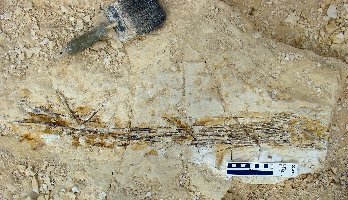 |
LEFT: I spent most of my time on the site doing
housekeeping things and talking to the landowner.... This is a picture of a lot of fin
rays near the back wall of the dig. I think they are probably from the tail. |
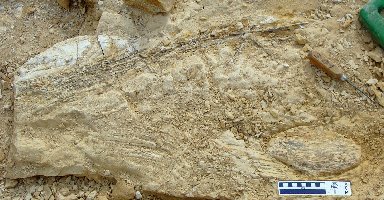 |
LEFT: Towards the end of the afternoon while working
on two separate groups of fin rays, I located a large chunk of bone called the hypural...
literally the base of the tail that connects the vertebral column to the flukes of the
caudal fin... After the heavy pectoral fins, it is the most often collected element of
this fish....
|
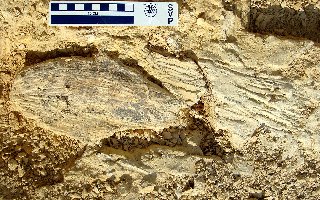 |
LEFT: This is a close-up of the hypural. There were
some fin rays (right side of the photo) that may actually have been from the caudal fin (I
think so) but I couldn't tell if the two were associated or if the hypural was just laying
on top of them. |
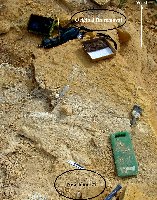 |
LEFT: In the process, I also encountered another area
of relatively large bones... but it was getting close to sundown, so I partially covered
the site and left it for the next trip. Looks like I will need to extend the dig another
couple of feet to the east... (where I was standing when I took this picture). The
critter just keeps growing... we now have both ends... e.g. the premaxilla and the base of
the tail... there is a good chance that we will recover most of the remains.... |
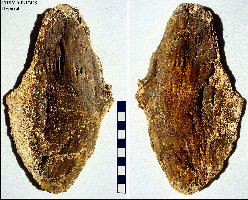 |
LEFT: A picture of the partially prepared hypural bone from the
big fish... nothing too exciting, except for the size... it's about 20 cm long... and
weighs almost a pound ... Note that there is a small piece of the posterior edge missing
- it should be nearly symmetrical ---- I have the piece but it is very thin
and delicate... still needs to be prepped out and reattached. You can also see small
indentations where the caudal fin rays would have been anchored....
RIGHT: This picture below gives you a comparison of the difference in
size between the hypurals of pachycormids - Bonnerichthys gladius and
Protosphyraena perniciosa... The smaller one would have come from a fish
that was about 4-5 feet long....(less than 2 m) |
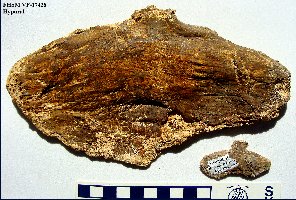 |
| August 26, 2009 |
|
|
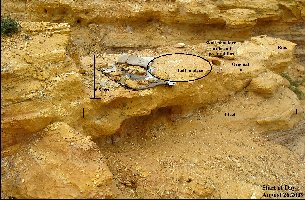 |
UPDATE (August 26, 2009 LEFT: This is an early
afternoon picture of the site before I started removing the rest of the specimen. It was
evident that there had been several major storms here in the last month and over an inch
of rain fell the day before. The chalk was wet, but the remaining bones were in good
shape. The final measurements of the "fossil floor" were 6.5 feet wide and
14 feet long...
Right: A photo of the area where the slabs containing the remaining bones were
removed. This area was covered with cardboard and rocks in the picture at LEFT. In
this picture, block #5 has already been taken up, along with a smaller piece that I
labeled block #4.5 since it abutted a piece that I removed in July. There were only three
individual fin rays observed in that piece.
|
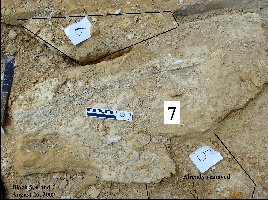 |
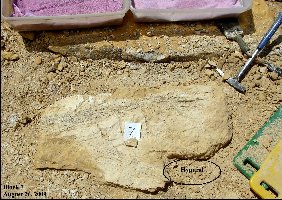 |
LEFT: Another view of block #7, after the removal of blocks #4 and
#5. The location of the hypural bone taken out in July is shown. RIGHT:
A closer view of block #7, showing what appears to be disarticulated and scattered
portions of the caudal fin. The extremely fractured nature of the underlying chalk
matrix also shows up well in this photo.. |
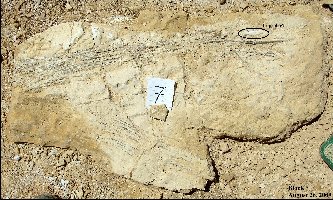 |
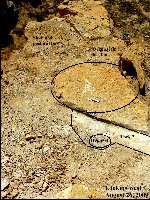 |
LEFT: A view of the dig site looking to the west while standing on
the undisturbed chalk on the east side. RIGHT: A view of the dig site
looking to the east while standing on the tip of the exposure. Note that the area marked
with the oval was left in place for the time being. It appears to contain only a few
scattered fin rays (closer view). A decision may be made to recover it at a
later date. Otherwise the fish remains have been removed, and are being prepared. |
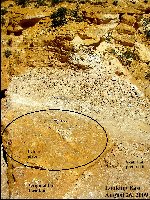 |
MARCH
11, 2010 - The partially prepared specimen arrives at the Sternberg Museum
Other
Oceans of Kansas web pages on Late Cretaceous fish:
Field Guide to Sharks and Bony
Fish of the Smoky Hill Chalk
Sharks:
Kansas Shark Teeth
Cretoxyrhina and Squalicorax
Ptychodus
Chimaeroids
Bony Fish
Pycnodonts and Hadrodus
Plethodids:
Pentanogmius
Martinichthys
Thryptodus
Bonnerichthys
Protosphyraena
Enchodus
Cimolichthys
Pachyrhizodus
Saurodon and Saurocephalus
Xiphactinus
Suggested references:
Cope, E.D. 1873. [On an extinct genus of saurodont
fishes]. Proceedings of the Academy of Natural Sciences of Philadelphia 24:280-281.
(meeting of Dec. 17, 1872) Wherein Cope names of the genus Erisichthe and
describes Erisichthe (Protosphyraena) nitida). <EM>
Cope, E.D. 1873. On two new species of Saurodontidae.
Proceedings of the Academy of Natural Sciences of Philadelphia 25:337-339. (naming of Portheus
lestrio (Xiphactinus audax), Portheus gladius (Protosphyraena
gladius) and Daptinus (Saurodon leanus).
Cope, E.D. 1874. Review of the vertebrata of the Cretaceous period found west
of the Mississippi River. U. S. Geol. Surv. Terr. Bull. 1(2):3-48.
Cope, E.D. 1875. The vertebrata of the Cretaceous formations of the West. Report,
U. S. Geol. Surv. Terr. (Hayden). 2:302 p, 57 pls.
Everhart, M. J. 2010. Bonnerichthys gladius
– The largest bony fish and first known planktivore from the Late Cretaceous. Kansas
Academy of Science, Transactions 113(1-2):123-124 (abstract).
Friedman, M., Shimada, K., Martin, L., Everhart, M.J., Liston, J., Maltese, A.
and Triebold, M. 2010. 100-million-year dynasty of giant planktivorous bony fishes in the
Mesozoic seas. Science 327:990-993.
Friedman, M.,
Shimada, K., Everhart, M.J., Irwin, K.J., Grandstaff, B.S. and Stewart, J.D. 2013.
Geographic and stratigraphic distribution of the Late Cretaceous
suspension-feeding bony fish Bonnerichthys
gladius (Teleostei, Pachycormiformes). Journal of Vertebrate Paleontology
33:35-47.
Hay, O.P. 1903. On certain genera and species of North American Cretaceous
Actinopterous fishes. Bull. Amer. Mus. Nat. Hist. XIX 1-95, pls. i-v, 72 text-figs.
Hibbard, C.W. 1942 A new chimaeroid fish from the
Niobrara Cretaceous of Logan County, Kansas. University Kansas Science
Bulletin 28-2(11):237-240, 4 fig.
Kear, B.P. 2007. First record of a pachycormid fish (Actinopterygii:
Pachycormiformes) from the lower Cretaceous of Australia. Journal of Vertebrate
Paleontology 27(4):1033-1038.
Leidy, J. 1857. Remarks on Saurocephalus and its allies. Trans. Amer.
Philos. Soc. xi pp. 91-95, with pl. vi.
Loomis, F.B. 1900. Die anatomie und die verwandtschaft der Ganoid-
und Knochen-fische aus der Kreide-Formation von Kansas, U.S.A. Palaeontographica, 46: 213-283,
pl. XIX-XXVII. (in German)
Mantell, G. 1822. The fossils of the South Downs; or illustrations of the
geology of Sussex. Lupton Relfe, London, xiv + 327 p., 42 p. (page 319 and plate 39, first
publication of a drawing the
fin of Protosphyraena)
Schultze, H.-P., J.D. Stewart, A.M. Neuner and R.W. Coldiron. 1982.
Type and figured specimens of fossil vertebrates in the collection of the University of
Kansas Museum of Natural History. Part I. Fossil fishes. Misc. Pub. University
Kansas Museum Natural History 73:53 pp.
Stewart, A. 1898. A contribution to the knowledge of the ichthyic
fauna of the Kansas Cretaceous. Kansas University Quarterly 7(1):22-29, pl. I, II. (Portheus
lowii sp. nov., Daptinus broadheadi sp. nov., Saurocephalus
dentatus sp. nov., Protosphyraena bentonia sp. nov., and Protosphyraena, sp. nov.)
Stewart, A. 1899. Notice of three new Cretaceous fishes, with remarks on the
Saurodontidae Cope. Kansas University Quarterly 8(3):107-112. (Xiphactinus, Protosphyraena
gigas and Empo [Cimolichthys])
Stewart, A. 1900. Teleosts of the Upper Cretaceous. The University Geological
Survey of Kansas. Topeka 6:257-403, 6 figs., pls. XXXIII-LXXVIII.
Stewart, J.D. 1979. Biostratigraphic distribution of species of Protosphyraena
(Osteichthyes: Actinopterygii) in the Niobrara and Pierre Formations of Kansas.
Proceedings of the Nebraska Academy of Sciences and Affiliated Societies, 89th Annual
Meeting, p. 51-52. (abstract)
Stewart, J.D. 1988. The stratigraphic distribution of late Cretaceous Protosphyraena
in Kansas and Alabama, Geology, In Nelson, M. E. (ed.), Paleontology and
biostratigraphy of western Kansas: Articles in honor of Myrl V. Walker, Fort Hays Studies,
3(10):80-94. (Science)
Stewart, J.D. 1990. Niobrara Formation vertebrate stratigraphy. pp. 19-30 In
Bennett, S. C. (ed.), Niobrara Chalk Excursion Guidebook, The University of Kansas
Museum of Natural History and the Kansas Geological Survey.
Woodward, A.S. 1895. Catalogue of the fossil fishes in
the British Museum. Part 3. British Museum of Natural History, London. pp.
i-xliii, 1-544, pls.

